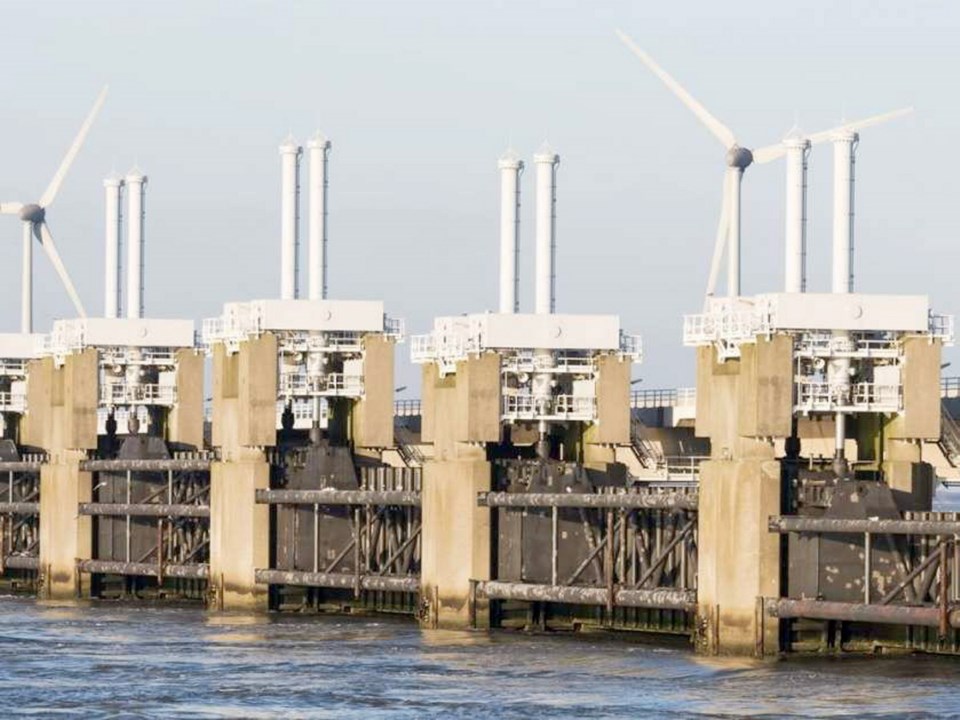The City of Vancouver is floating the idea of constructing a sea gate — a storm surge barrier — under the Burrard Bridge to prevent future flooding of Granville Island and the False Creek Flats, from the coastline to Clark Drive.
With the local sea level projected to rise by as much as a metre over the next century and the one-two punches of storm surges and king tides already hammering coastal infrastructure, staff are preparing options to present to councillors next month.
Those options range from doing nothing and hoping for the best to intricate and complex solutions. And the options vary by neighbourhood.
The most significant among them would be a sea gate at the mouth of False Creek. Sea gates are large, complex, and often-expensive, barriers that can be closed as needed to hold back surging seas and protect valuable, low-lying land. The best-known examples are in the Netherlands, including its Oosterscheldekering, a three-kilometre-long structure that some herald as a wonder of the world.
Doug Smith, Vancouver’s acting director of sustainability, said a sea gate at the narrowest point of False Creek could form part of a larger effort to prevent the estimated billions of dollars of damage that a future flood could cause. In a recent interview, Smith painted the sort of scenario the city is preparing for — one brought on by a high tide, surging water and a projected increase in sea level.
“We would envision most of the False Creek Flats — like all the way up to Clark Street — flooded. We would see Granville Island underwater. You would see the Olympic Village and multiple other areas around the False Creek area with a couple of feet of water,” Smith said.
“That’s the bad news. The good news is that we’ve got lots of time. We’re looking at 2050 before we start really worrying about False Creek, and so over the next couple of years we can really start stretching our imaginations trying to figure out what we could do and how it would look.”
So far, staff have identified four other options for False Creek. They include moving everyone out of the flood plain and demolishing the buildings, doing nothing, or raising the False Creek seawall by two-and-a-half metres to turn it into a dike. But Smith said such a dike would need to be about eight kilometres long, would block views of the water and would sever people’s connection with the waterfront.
Elsewhere in the city, dikes or metal barriers make more sense, he said. One such area is along Waterfront Road downtown, an area that has key infrastructure including railway tracks, SkyTrain lines and the SeaBus terminal. Another is Jericho Beach Park, where staff now combat storm surges with sandbags.
The rising sea will also force a significant decision about the future of Stanley Park. The city projects the area around Lost Lagoon could flood. While it could be protected, a decision could be made not to intervene, effectively turning Stanley Park into Stanley Island, Smith said.
He again cautioned that there is time. “This isn’t a panic. We’re not worried about the city going under water in the next five or ten years.”
But for Mayor Gregor Robertson, that doesn’t mean the problem can be ignored.
“Every city, globally, will be spending billions of dollars to deal with climate change and sea level rise if they’re on the ocean,” he said. “Many of the world’s big cities are facing massive infrastructure costs due to climate change. That’s just a reality.”
Robertson said the city has already incurred costs from storm damage to the seawall and the Kitsilano pool, events he referred to as “early warnings.”
When asked whether the city could afford to pay for major infrastructure like that being considered, he said “we don’t have a choice.”
He went on to say that the likely delay before a rapid rise in sea levels means there is time to stretch investment dollars out. “But that means we need to start now.”
Sadhu Johnston, Vancouver’s city manager, said city staff have been looking at the issue for several years and plan to consult with residents on their findings.



